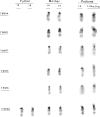Abstract
We have employed molecular probes and in situ hybridization to investigate the DNA sequences flanking the breakpoint of a group of t(14q21q) Robertsonian translocations. In all the families studied, the probands were patients with Down syndrome who carried a de novo t(14q21q) translocation. The DNA probes used were two alphoid sequences, alphaRI and alphaXT, which are specific for the centromeres of chromosomes 13 and 21 and of chromosomes 14 and 22, respectively; a satellite III sequence, pTRS-47, which is specific for the proximal p11 region of chromosomes 14 and 22; and a newly defined satellite III DNA, pTRS-63, which is specific for the distal p11 region of chromosome 14. The two alphoid probes detected approximately the same amount of autoradiographic signal on the translocated chromosomes as was expected for chromosomes 14 and 21 of the originating parent, suggesting that there has been no loss of these centromeric sequences during the translocation events. Results with the two satellite III probes indicated that the domain corresponding to pTRS-47 was retained in the translocated chromosomes, whereas the domain for pTRS-63 was lost. These results have allowed us to place the translocation breakpoint between the pTRS-47 and pTRS-63 domains within the p11 region of chromosome 14.
Full text
PDF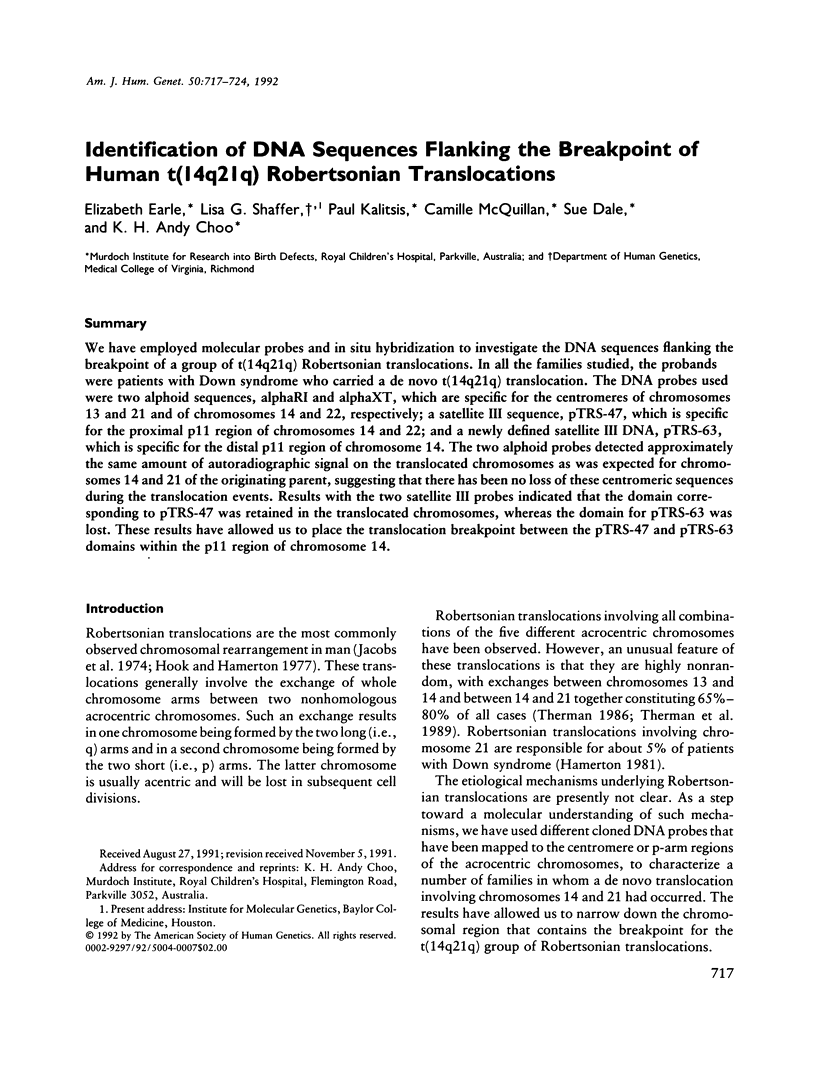
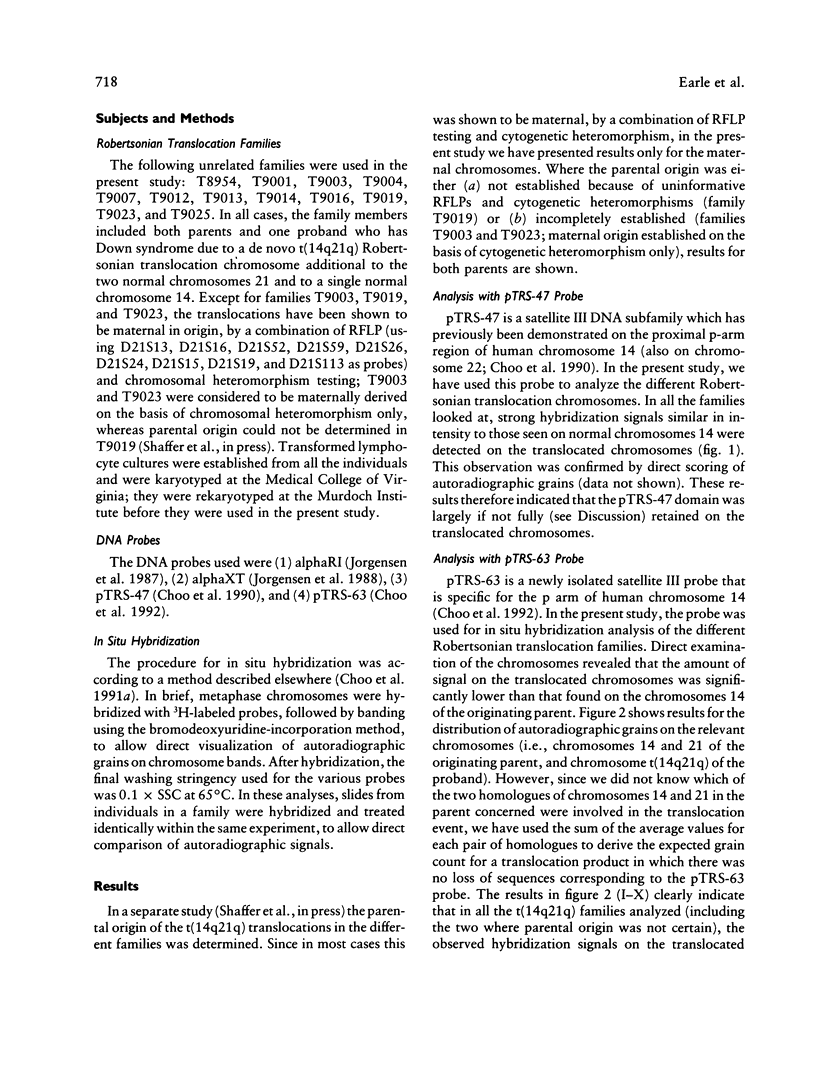



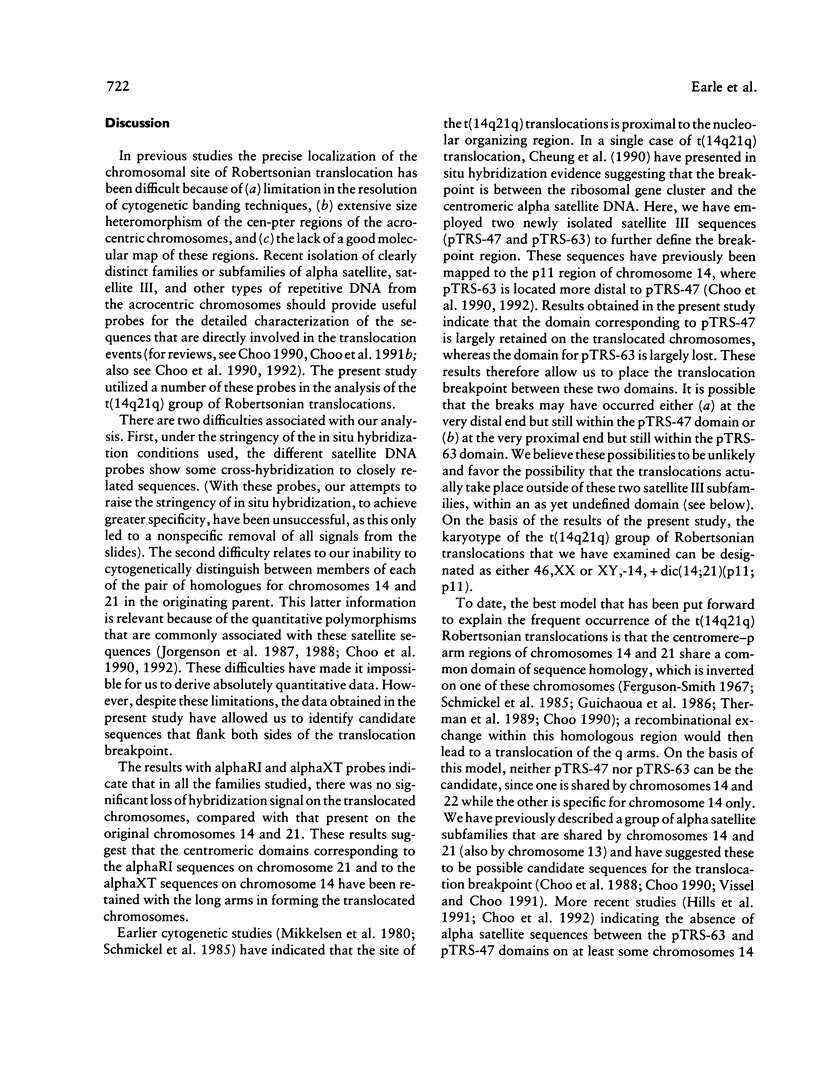
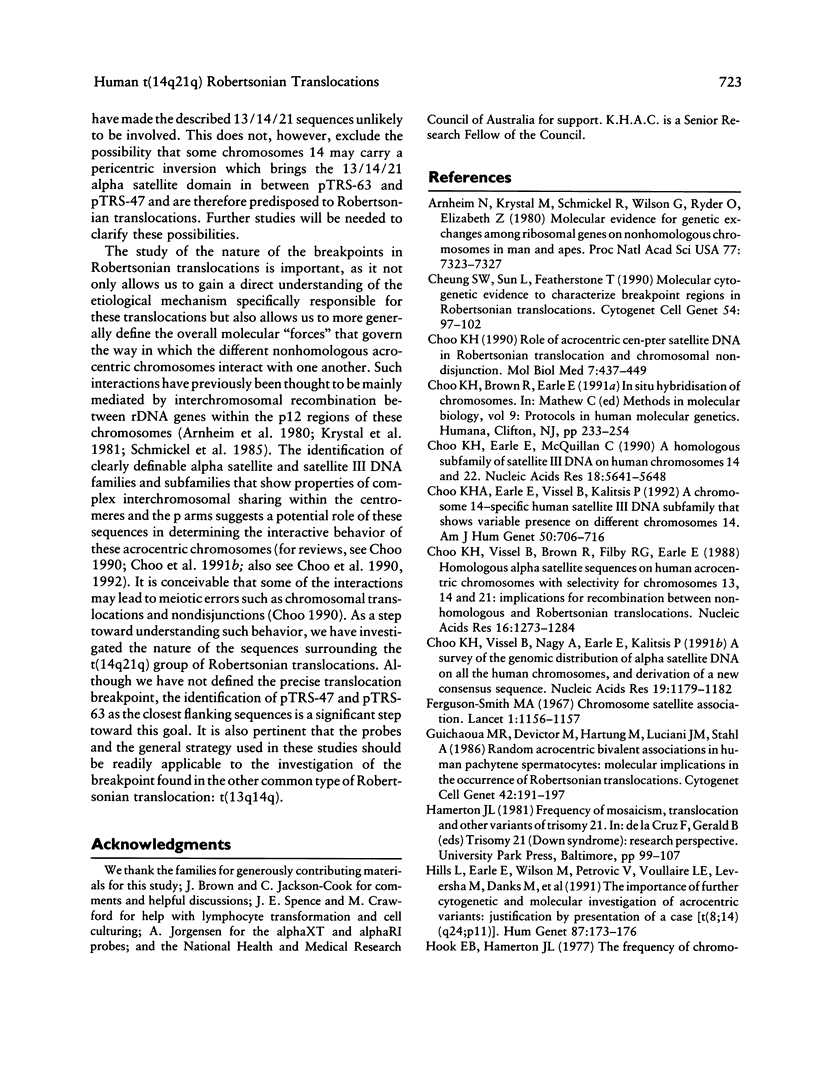

Images in this article
Selected References
These references are in PubMed. This may not be the complete list of references from this article.
- Arnheim N., Krystal M., Schmickel R., Wilson G., Ryder O., Zimmer E. Molecular evidence for genetic exchanges among ribosomal genes on nonhomologous chromosomes in man and apes. Proc Natl Acad Sci U S A. 1980 Dec;77(12):7323–7327. doi: 10.1073/pnas.77.12.7323. [DOI] [PMC free article] [PubMed] [Google Scholar]
- Cheung S. W., Sun L., Featherstone T. Molecular cytogenetic evidence to characterize breakpoint regions in Robertsonian translocations. Cytogenet Cell Genet. 1990;54(3-4):97–102. doi: 10.1159/000132970. [DOI] [PubMed] [Google Scholar]
- Choo K. H., Earle E., McQuillan C. A homologous subfamily of satellite III DNA on human chromosomes 14 and 22. Nucleic Acids Res. 1990 Oct 11;18(19):5641–5648. doi: 10.1093/nar/18.19.5641. [DOI] [PMC free article] [PubMed] [Google Scholar]
- Choo K. H., Earle E., Vissel B., Kalitsis P. A chromosome 14-specific human satellite III DNA subfamily that shows variable presence on different chromosomes 14. Am J Hum Genet. 1992 Apr;50(4):706–716. [PMC free article] [PubMed] [Google Scholar]
- Choo K. H. Role of acrocentric cen-pter satellite DNA in Robertsonian translocation and chromosomal non-disjunction. Mol Biol Med. 1990 Oct;7(5):437–449. [PubMed] [Google Scholar]
- Choo K. H., Vissel B., Brown R., Filby R. G., Earle E. Homologous alpha satellite sequences on human acrocentric chromosomes with selectivity for chromosomes 13, 14 and 21: implications for recombination between nonhomologues and Robertsonian translocations. Nucleic Acids Res. 1988 Feb 25;16(4):1273–1284. doi: 10.1093/nar/16.4.1273. [DOI] [PMC free article] [PubMed] [Google Scholar]
- Choo K. H., Vissel B., Nagy A., Earle E., Kalitsis P. A survey of the genomic distribution of alpha satellite DNA on all the human chromosomes, and derivation of a new consensus sequence. Nucleic Acids Res. 1991 Mar 25;19(6):1179–1182. doi: 10.1093/nar/19.6.1179. [DOI] [PMC free article] [PubMed] [Google Scholar]
- Guichaoua M. R., Devictor M., Hartung M., Luciani J. M., Stahl A. Random acrocentric bivalent associations in human pachytene spermatocytes. Molecular implications in the occurrence of Robertsonian translocations. Cytogenet Cell Genet. 1986;42(4):191–197. doi: 10.1159/000132277. [DOI] [PubMed] [Google Scholar]
- Hills L., Earle E., Wilson M., Petrovic V., Voullaire L. E., Leversha M., Danks D. M., Choo K. H. The importance of further cytogenetic and molecular investigation of acrocentric variants: justification by presentation of a case [t(8;14)(q24;p11)]. Hum Genet. 1991 Jun;87(2):173–176. doi: 10.1007/BF00204176. [DOI] [PubMed] [Google Scholar]
- Jacobs P. A., Melville M., Ratcliffe S., Keay A. J., Syme J. A cytogenetic survey of 11,680 newborn infants. Ann Hum Genet. 1974 May;37(4):359–376. doi: 10.1111/j.1469-1809.1974.tb01843.x. [DOI] [PubMed] [Google Scholar]
- Jørgensen A. L., Bostock C. J., Bak A. L. Homologous subfamilies of human alphoid repetitive DNA on different nucleolus organizing chromosomes. Proc Natl Acad Sci U S A. 1987 Feb;84(4):1075–1079. doi: 10.1073/pnas.84.4.1075. [DOI] [PMC free article] [PubMed] [Google Scholar]
- Jørgensen A. L., Kølvraa S., Jones C., Bak A. L. A subfamily of alphoid repetitive DNA shared by the NOR-bearing human chromosomes 14 and 22. Genomics. 1988 Aug;3(2):100–109. doi: 10.1016/0888-7543(88)90139-5. [DOI] [PubMed] [Google Scholar]
- Krystal M., D'Eustachio P., Ruddle F. H., Arnheim N. Human nucleolus organizers on nonhomologous chromosomes can share the same ribosomal gene variants. Proc Natl Acad Sci U S A. 1981 Sep;78(9):5744–5748. doi: 10.1073/pnas.78.9.5744. [DOI] [PMC free article] [PubMed] [Google Scholar]
- Schmickel R. D., Gonzalez I. L., Erickson J. M. Nucleolus organizing genes on chromosome 21: recombination and nondisjunction. Ann N Y Acad Sci. 1985;450:121–131. doi: 10.1111/j.1749-6632.1985.tb21488.x. [DOI] [PubMed] [Google Scholar]
- Therman E., Susman B., Denniston C. The nonrandom participation of human acrocentric chromosomes in Robertsonian translocations. Ann Hum Genet. 1989 Jan;53(Pt 1):49–65. doi: 10.1111/j.1469-1809.1989.tb01121.x. [DOI] [PubMed] [Google Scholar]
- Vissel B., Choo K. H. Four distinct alpha satellite subfamilies shared by human chromosomes 13, 14 and 21. Nucleic Acids Res. 1991 Jan 25;19(2):271–277. doi: 10.1093/nar/19.2.271. [DOI] [PMC free article] [PubMed] [Google Scholar]



